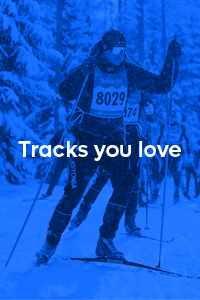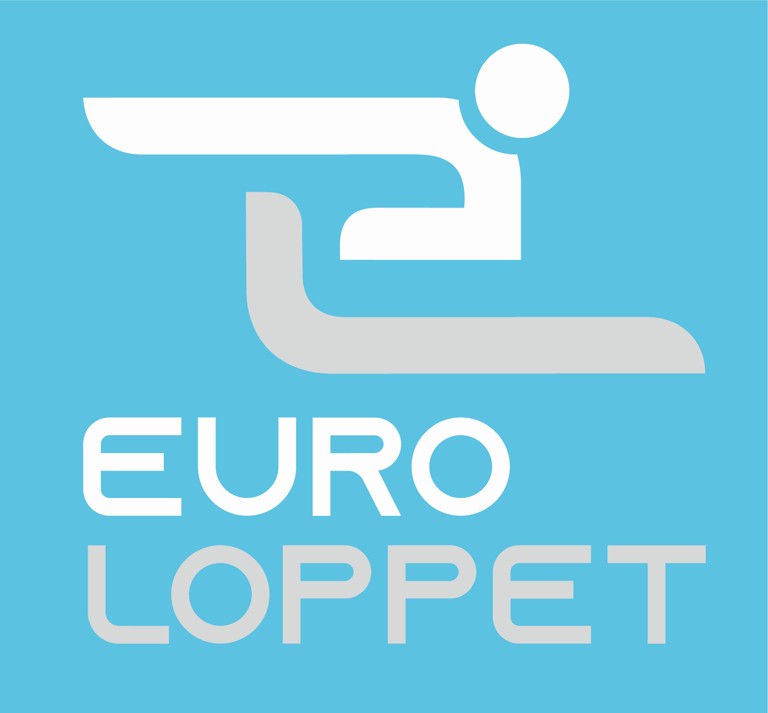Becoming a Worldloppet Master should be easy, shouldn’t it?
A story by Timothy Stellmacher, Worldloppet Master #5386, March 2023
In late October 1976 in the state of Wisconsin in the USA, my brother and I decided to purchase cross-country skis. We had spent the ’75-‘76 winter primarily indoors and we were looking for a healthy, outdoor, winter lifestyle. We decided to buy cross-country skis. Just before Thanksgiving that year, we picked up our skis, boots, and poles from the sporting goods store and we were ready. We just needed snow.
Our wish was fulfilled, for just before Thanksgiving of that year, our hometown of Ripon, Wisconsin received an 8”/20 cm snowfall. So, it was on Thanksgiving Day 1976 that I tried on my new cross-country skis for the first time. I did a dozen laps around my parents’ house. Although breaking tracks for the first time ever was strenuous, I was enthused to be outside in winter snow doing a sport that I came to love.
My brother and I took every chance that we had to cross-country ski that winter. One of those times was at a golf course in the Green Lake, WI area. It was -26 degrees C/ -15 degrees F that day. As we skied across the golf course on the classic ski tracks, we started to reconsider if cross-country skiing was really that great. But THEN, we entered the woods, and it became a different, warmer world. From that point on, we both looked eagerly forward to winter. Cross-country skiing was exactly the activity we had been looking for.
Fast forward to retirement 2015
In those next two to three years, I cross-country skied every chance I had. Two highlights in the first two months of 1978 stand out. First, on our first date, I took my future wife cross-country skiing (and decided to marry her on the way back to her house); second, that was the year that I and my roommate decided to compete in the American Birkebeiner Ski Race near Cable, Wisconsin. The race was 55 km long starting with an imposing climb up the headwall of the Mt. Telemark Ski Resort. We started in the last wave, Wave 9. Conquered the headwall with some effort, and 8 hours and 1 minute later, crossed the finish line on the lake just outside of downtown Hayward, Wisconsin. I had never been so tired in my entire life.
After that race, I married, and children came into our life. With our two fulltime careers, our family cross-country skied often, but not at the frequency of the marvelous first years of my cross-country skiing. So, in 2006, with all three kids at universities or finished with studies, it was time to get serious again. That year, a friend from West Bend, Wisconsin and his two sons drove with me to northern Wisconsin to ski the Birkebeiner Race. The two sons skied the full 50+ km Birkebeiner Ski Race. My friend and I skied the Korteloppet Short Race which was only 25 km (15+ miles). Once again, my enthusiasm for cross-country skiing was kindled.
Until my retirement in July 2015, I managed to ski the Korteloppet Race four more times. And, with retirement pending, I discovered the Worldloppet, a circuit of 20 cross-country ski races in 20 countries worldwide. I also discovered that if you completed 10 of the 20 international Worldloppet Races, you would achieve Worldloppet Master status. Thus, my goal in retirement was to become a Worldloppet Master. It looked easy, for I foresaw that I could do two international races a year. Where to start? The answer was easy. Germany, where I had studied for 5 semesters as a student and had visited uncountable times on business trips.
The first international race in 2016 would be the König Ludwig Lauf near Oberammergau at the base of the Alps in Germany. My youngest daughter and her husband, now both avid cross-country skiers would join me. As the trip approached, it would become clear that there would be not sufficient snow for the race. One week before the race was to be held, it was cancelled. We travelled to Oberammergau anyway.
While disappointed, I still had the second planned international race to ski that winter: the race in Gatineau, Ontario, Canada. As we arrived in Gatineau, we saw that sufficient snow would not be the problem. As I began the Gatineau Loppet, the temperature was minus 2 degrees C/ 28 degrees F. I felt good. The $100 that I had paid for professional waxing of my skis appeared to be a great investment. But, in the next three hours, the temperature rose to +13 degress C/ +56 degrees F. At that temperature, the wax on my skis became totally ineffective and the major hills in the middle of the race challenged my fitness. But I finished and my 2nd Worldloppet Race now recorded.
The 2017 goal was to ski the Austrian Race in Obertilliach. Again, my daughter and her husband accompanied me. And again, the amount of snow was a problem. Instead of skiing from the Biathlon Center in Obertilliach down the valley to Lienz, we skied a modified peanut-shaped alternate course twice to complete the 20 km distance. Not ideal, but my 3rd Worldloppet, the Dolomitenlauf, was finished.
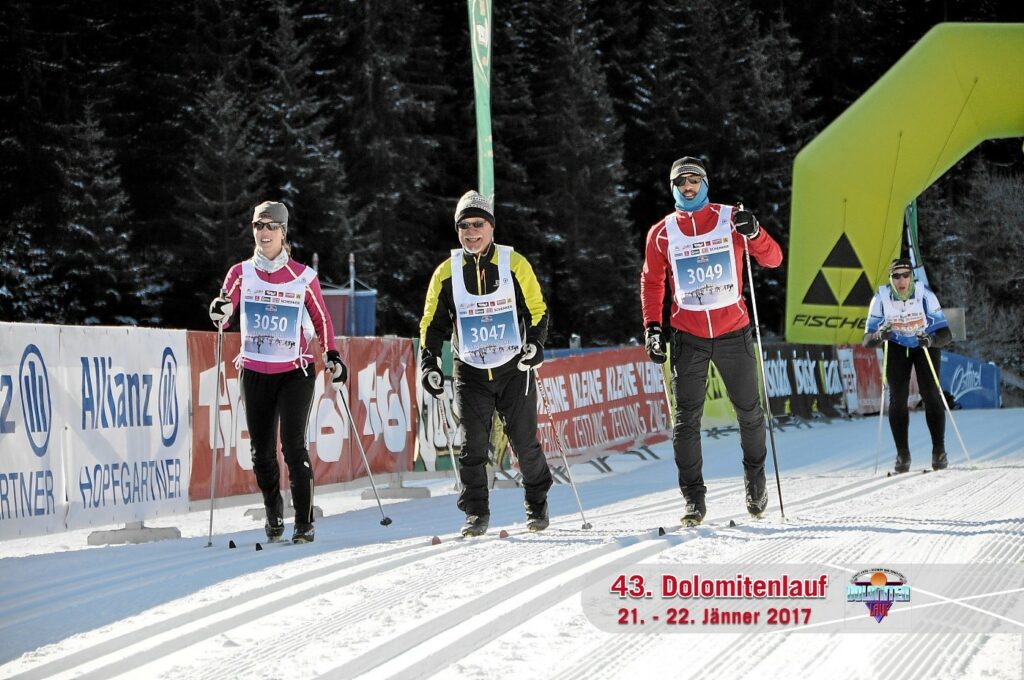
Winter 2018 had two goals. Complete the Marcialonga Race (short) in northern Italy with a former German business colleague and then, 10 days later, return to Oberammergau, Germany to finally ski the German Worldloppet race. Both races went well. The Marcialonga had sufficient snow and the König Ludwig Lauf would become my favorite Worldloppet race yet. It snowed big, softly falling flakes for the last 10 kilometers. Although it slowed my progress, it was peaceful and enjoyable. It was a great way to complete Worldloppet race number 5. Half-way!
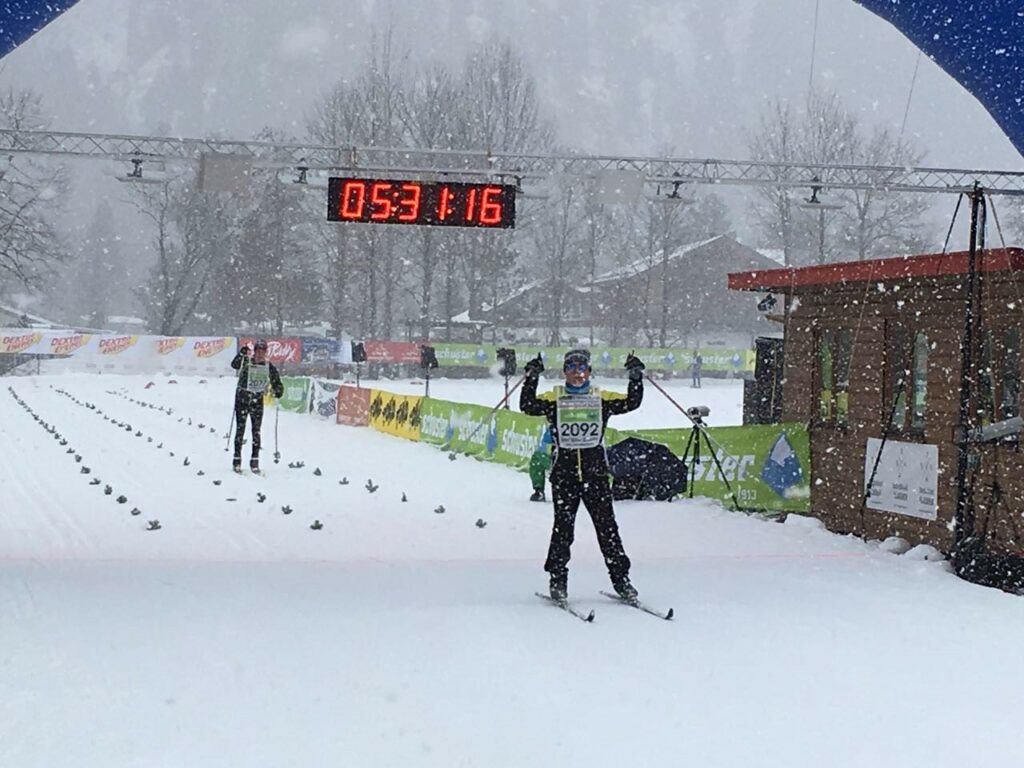
The Winter 2019 target would be the Transjurassienne Race in France. My wife and I flew into Germany, visited the daughter of our dear German friends, and visited some small cities in Germany on the way to France. We kept hoping that the weather would improve as we landed in Frankfurt am Main, Germany. It would not improve. In fact, it rained for three days before the race. It only stopped raining just as the starting gun for the Transju Race went off. I had never skied on such wet snow. The race would have been beautiful, skiing down the valley to the finish. But, not on that day! The snow was wet and slippery, and one had to totally pay attention, especially on some critical downhills. I finished the 25 km just under 3 hours and Worldloppet Race Number 6 was achieved.
The Winter 2020 would target two Worldloppet races: the Jizerska50 in the Czech Republic and the Tartu Maraton in Estonia. Both races would be in countries unfamiliar to me and my wife. We landed in Prag and drove across bare ground en route to the race course near Harrachov, Czechia. Only as we gained altitude nearing the city of Liberec, the site of our hotel, did the amount of snow on the ground increase. We checked into the hotel and awoke the next day with 6” of new snow on the ground. Hooray! The race course should be okay for the race two days later. Nope.
The night before the race, an icy mist fell on the course, making it a challenge. Especially the long, gradual climb at the beginning of the 25 km race. But I was happy to be skiing and my enthusiasm for cross-country skiing carried the day. Worldloppet Race Number 7 done!
Unfortunately, the night before the Czech Race, I received information that the Estonian 31 km Worldloppet Classic Race that I was planning to do was cancelled due to inadequate snow. Disappointed, we re-routed our flights and headed home—just ahead of the Covid pandemic that was about to begin in the United States.
The Covid outbreak in late Winter 2020 prevented any thoughts of doing Worldloppet Races internationally for the next two years. However, I was able to complete the 26 km American Kortelopet Race virtually in 2021, that is, my daughter, son-in-law, and I skied 26 km that morning and reported to the American Birkebeiner Office in Hayward, Wisconsin that we had confirmed the distance by Apple Watch. But the 2021 Kortelopet did not count towards the goal of 10 Worldloppet International Races as I had completed 11 Kortelopets previously.
The Final Worldloppet Quest
In the Spring of 2023, I am now three years older and stuck on 7 Worldloppet Races completed. I decide to try to do three races in 12 days to complete the goal of 10 Worldloppet Races. With 10 races complete, I would become a Worldloppet Master. I am determined and decide to begin jogging again in the Summer 2022. Until the Summer 2022, I had attempted several times to begin jogging again, but each time I would give up after a few days because of sore knees. This time would be different.
I found the program Couch-to-5K online, purchased new sneakers, and, in the next 6 weeks, was actually able to jog 5 km in about 40 minutes. In addition, I added “polewalking” 2-3 times per week, that is, I would walk the local cross-country ski hills with my ski poles. Funny how polewalking motivates one to seek out hills to climb!
In Fall 2022, I gained additional confidence that I would achieve my goal. Our daughter and son-in-law made reservations at Bearskin Lodge in northern Minnesota for the beginning of December. We traveled to northern Wisconsin prior to driving further to northern Minnesota and we were rewarded with several inches of snow on the ground. Thus, I was able to get two “bonus days” of skiing in. The four days at Bearskin Lodge were a winter wonderland. While not yet ski race distances, the skiing was the best of the season and I was achieving the endurance I would need for the races in early 2023.
Upon returning home to West Bend, WI, the next two months would provide below average opportunity to build on the race preparation. I did manage to ski several times, both locally and at the new Ariens Nordic Ski Center in Brillion, WI, but I was not able to build on the training that I had done so far. Finally, departure day arrived and we drove to Chicago to fly to Europe for the races.
Worldloppet Race Number 8 was to be in Lahti, Finland. All Winter 2023 I had monitored the snow conditions, not only in Lahti, but also at the other two race venues in Poland and in Switzerland. At least the Finlandia Hiihto Race had not been cancelled! We arrived in Lahti three days before the race and explored the town. We were appreciative of the natives as nearly everyone spoke English very well. I was excited to get the first race done.
We walked to pick up the Bib Packet the day before the race and we saw that the race would begin and end at the foot of three giant ski jumps. Lahti had been the site of the 1972 Winter Olympics and the sight of the ski jumps at the start of the race gave me an adrenaline boost. Snow conditions were adequate even though the classic tracks were slowed by tiny snow-ice crystals during the race. The race course proved manageable, even a very icy curve about 500 meters from the finish. I finished the 20 km race with some energy to spare. Worldloppet Number 8 complete!
We departed Lahti for Frankfurt a.M., Germany the next day. I had 8 days of rest before the next race near Szklarska Poreba, Poland. We spend the next 4 days in Bad Nauheim, Germany with long-time German friends before departing for the Polish Race. Once again, there was little snow on the ground en route to Szklarska Poreba. But, I had not been notified of race cancellation, so we drove onward. Just as three years before in Czechia, snow appeared at higher elevations as we neared our hotel. While temperatures were slightly above freezing the two days prior to the race, it appeared at Bib Pickup that snow conditions would be adequate.
Taking the bus from our hotel to the Bieg Piastow Race Center, it began to snow. This race, too, would begin and end at the same place. That meant that my Race Manager wife would be able to stay warm during the three and a half hours that I would need to complete the 25 km course. It began snowing before the start of the race. Luckily, the first 15 km were level and even slightly downhill. But after 17 km, the course climbed, not steeply, but challenging.
In fact, the course had one of the longest hills that I had encountered in any of the Worldloppet races so far. My progress was slowed by the fresh snow on the course, but with determination, I was able to finish close to my predicted time of three and one-half hours. Whew! I had expected this race to be the most difficult, but I was surprised at how much energy I had expended. Worldloppet Number 9 complete!
The next day, we arose early for a long drive south in the direction of the third and final race near Pontresina, Switzerland. We broke up the drive into Switzerland by stopping near Füssen, Germany. We stayed at the same hotel that we had discovered six years before and we were rewarded with the best breakfast in all of Germany. After driving through Austria, we arrived that the Swiss race site. For 20 km, we drove along what looked like an artificial race course. We surmised that this was the reason that the Engadin Skimarathon had not been cancelled. And we were correct.
After two days of much needed rest, the third and final race of my 2023 Worldloppet Quest was to take place at night. On the day before the race, we had driven to the start location and had observed skiers along the presumed route. The race course would go by the alpine village of St. Moritz. We saw skiers on the snow-covered lake, part of which was still open. Again, as at the other two race venues earlier, the daily temperatures hovered just above freezing. I remained determined to finish this last race as, on paper, it looked to be the easiest at only 17 km. That was a wrong assumption!
Near our hotel, I boarded the bus that would take me to the start of the race. I had everything that I needed including a mandatory headlamp. I arrived at the start about one hour before the start. While other skiers were already taking a few strides to test snow conditions, I kept my skis at my side. Skies darkened as I changed into my ski boots and delivered my jacket and hiking boots to the truck that would bring them to the finish. Finally, with headlamps on for all the skiers, the race began. It was a mass start with all 600 skiers moving forward at the same time.
Within a kilometer of the start, the surprises began. While the experienced Night Race skiers swerved left to avoid the slushy tracks, I plowed through the inch of wet snow on the tracks. After a few kilometers, the slush was replaced with snow, but now at freezing temperatures, the tracks became icy. In spite of these conditions, the tracks were mostly flat across the small lakes and the first part of the race went rather well. Most of the 600 skiers at the start were skating, i.e. skiing free style.
I was among a small group of skiers classified as Volksläufer, traditional classic style skiers. Soon, I and some of the other skiers were skiing alone on the course which was lit only by our headlamps. By the lights of the village of St. Moritz to my left, I estimated that I had covered at least half the 17 km course. But then, the classic tracks disappeared. I skied on trying to navigate the now mostly barely snow-covered icy course.
Instead of the course continuing along St. Moritzer Lake, the course took a turn uphill to the right. This slight gain in altitude did not improve the course, for it remained dark and icy. Navigating uphill on the trackless course was do-able, but soon the ultimate challenge appeared: how to navigate the downhills on an icy track IN THE DARK. Twice I removed my skis to walk down a steep curvy hill.
Finally, I heard the loud speakers in the distance announcing the skiers who were finishing ahead of me. The final kilometer of the course snaked down the mountain side. While here there was adequate snow, the course remained icy as the skiers finishing ahead of me had “plowed” the snow to the side as they traversed the final curves to the finish. I assumed my final low crouch to cover this last final stretch to the finish, staying as low as possible in case of a fall.
I did not fall and skied triumphantly across the Finish. The final race was supposed to be the easiest. It ended up the hardest of the ten races that I had completed. But, I had done it! In spite of the wet snow, the dark, the lack of tracks, the ice, and the formidable icy downhill curves, I had finished Worldloppet Race Number 10. I was now, at age 76, a Worldloppet Master!
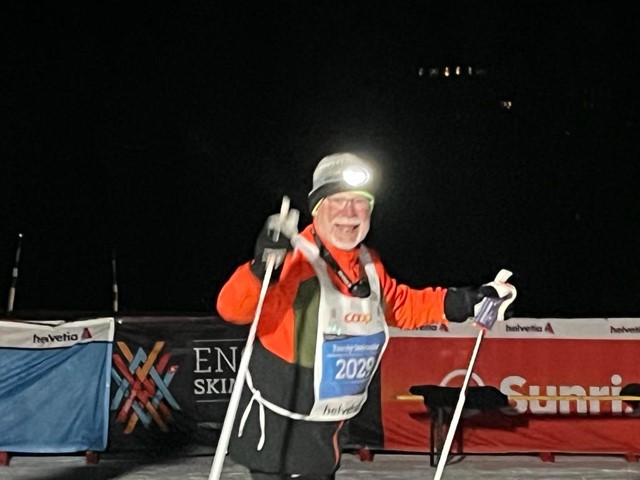
Tim Stellmacher is a School Business Management Consultant. He has looked forward to snowfall in Wisconsin, USA each and every winter since 1976.
Do you also want to become a Worldloppet Master? Do you accept the challenge? Then get your own Passport and start skiing around the world.
BACK
